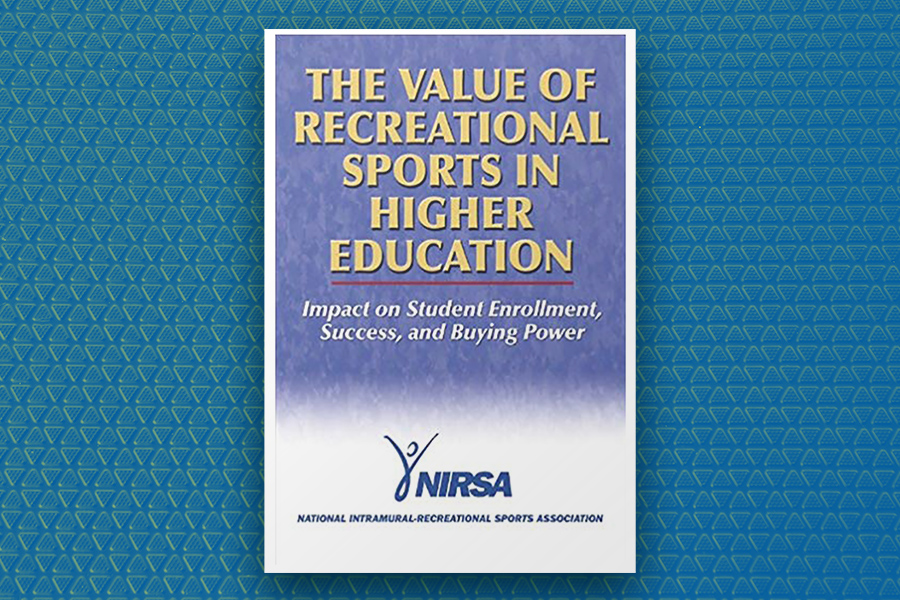What attracts students to a college—academics? recreational sports? the campus recreation center? If you selected all three answers, you are right.
Most students choose a college or university for its academic merits, but another key factor in their decision is the recreational sports programs and facilities. Recreational sports are an important component to students’ quality of life on campus and to a college’s recruitment and retention of students. NIRSA contracted Kerr-Downs Research Associates to conduct a nationwide research project to determine the value of recreational sport on college campuses. More than 2,600 students from 16 colleges participated in this study, making it the largest representative group of college students from multiple colleges ever studied with respect to the value of participation in recreational sports. This study examined the value and contributions of recreational sports to participants’ lives and documented the buying power of participants in recreational sports. The first of its kind in research, The Value of Recreational Sports in Higher Education makes a strong the case for campus recreational sports programs and facilities that will support the mission of your college into the future.
About the Author
NIRSA is the leading resource for professional and student development, education, and research in collegiate recreational sports. Headquartered in Corvallis, Oregon, NIRSA was established in 1950 at a meeting of 22 African American men and women from 11 Historically Black Colleges and Universities at Dillard University. NIRSA now has nearly 4,000 highly trained professional, student, and associate members throughout the United States, Canada, and other countries. NIRSA members serve an estimated 5.5 million students who regularly participate in campus recreational sport programs. NIRSA’s mission is to provide for the education and development of its members and to foster effective recreational programs, facilities, and services for diverse populations. The association’s commitment to excellence is shown in its use of resources that promote ethical and healthy lifestyle choices.
Table of Contents
Section I. The Value of Recreational Sports on College Campuses
Introduction–Surveys of Rec Sports Participants
Executive Summary
Previous Research on the Value of Recreational Sports on College Campuses
Determinants of College Satisfaction & Success
Allocation of Money on Campus
Happiness with College Experience
Benefits of Recreational Sports
Selected Behaviors and Recreational Sports Participation
Profile
Section II. Recreational Sports Expenditure Survey
Introduction–Survey of Recreational Sports Personnel
1. Director of Recreational Sports
2. Associate Director
3. Assistant Director
4. Coordinator
Executive Summary
Findings
Background and Profile Information
Existing Campus Recreational Centers/Complexes
Planned Recreational Facilities
Annual Expenditures
Food Service
Recreational Sports Budgets
Promotions
Purchasing Authority
Section III. Buying Power of Recreational Sports Participants
Introduction: This section presents the results of a survey of rec sports participants. College students were requested to indicate how much they had spent in the past 30 days for the following 18 items or activities:
Athletic apparel/clothes
Restaurants
Food (grocery stores, convenience stores)
Cars (gas, repair)
Athletic shoes
Clothes, shoes (excluding athletic clothes or athletic shoes)
Athletic equipment
Soft drinks, sports drinks
Personal care, toiletries
Vitamins, health supplements, health food
Bottled water
Household items
Videos, movies, DVDs, CDs, headsets
Sporting events, concerts, clubs
TVs, radios, stereos
Computers, pagers, CD burners, PDAs, cell phones
Travel/vacation
Alcohol, cigarettes
Bibliography
Appendix
Audiences
Resource for recreational sports program and facility administrators; purveyors of recreational sports equipment and services; companies involved in planning and building of recreational facilities; other college and university departments such as admissions, campus activities, and capital fundraising. Textbook for college and university courses in recreation and leisure studies, recreational and sports management, and sports marketing.
For questions regarding this publication, please contact NIRSA Senior Director of Operations Mary Callender.


